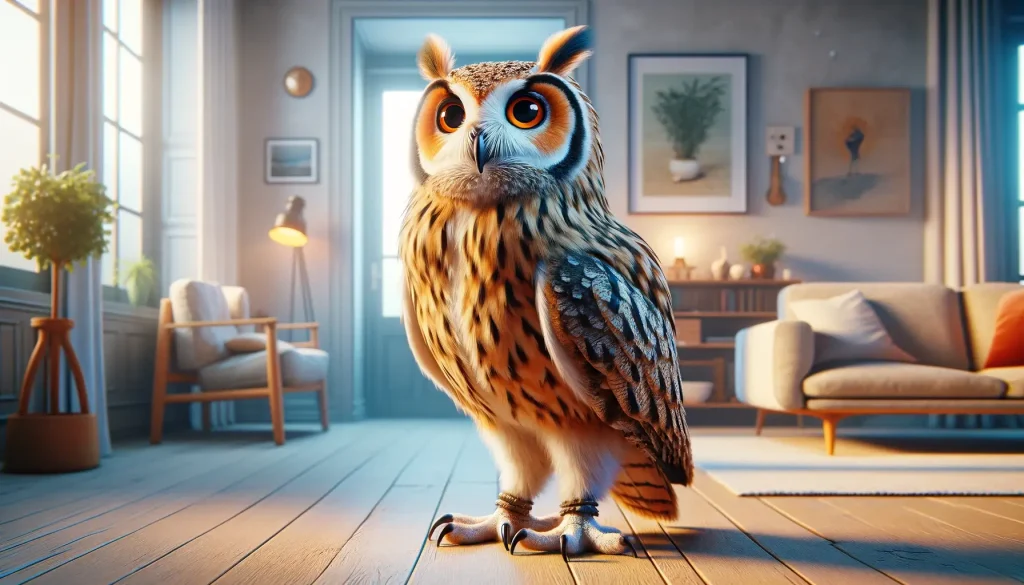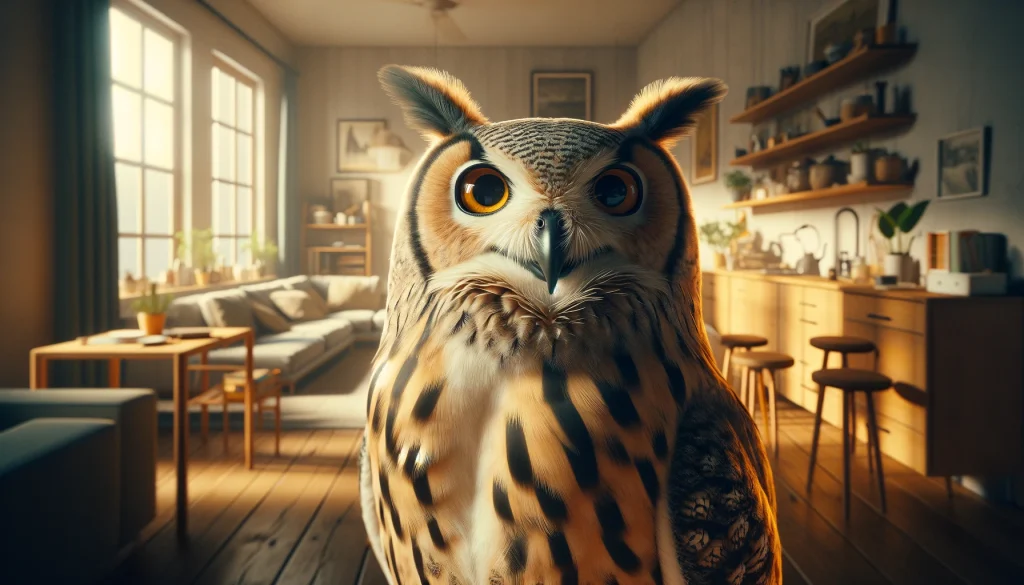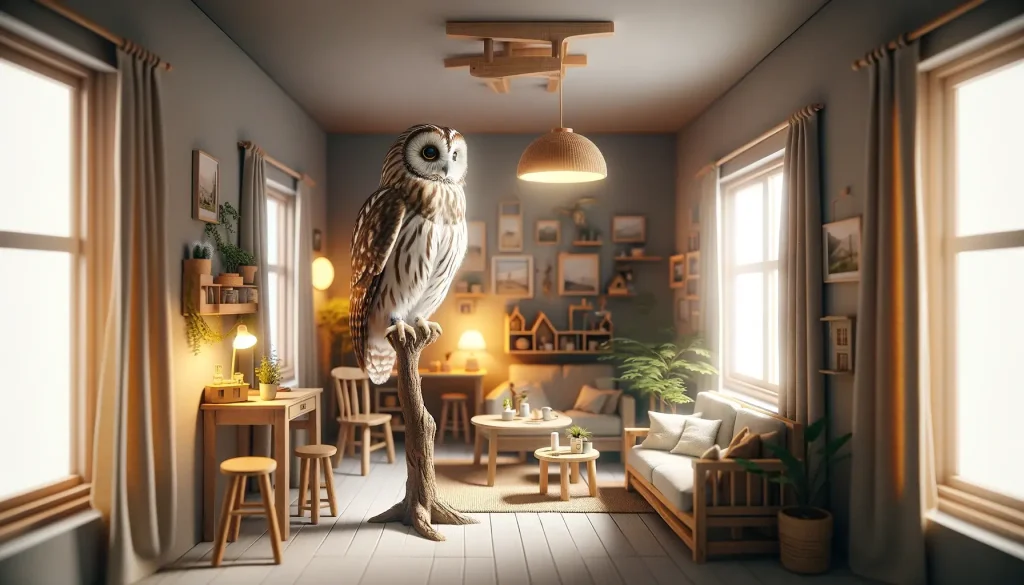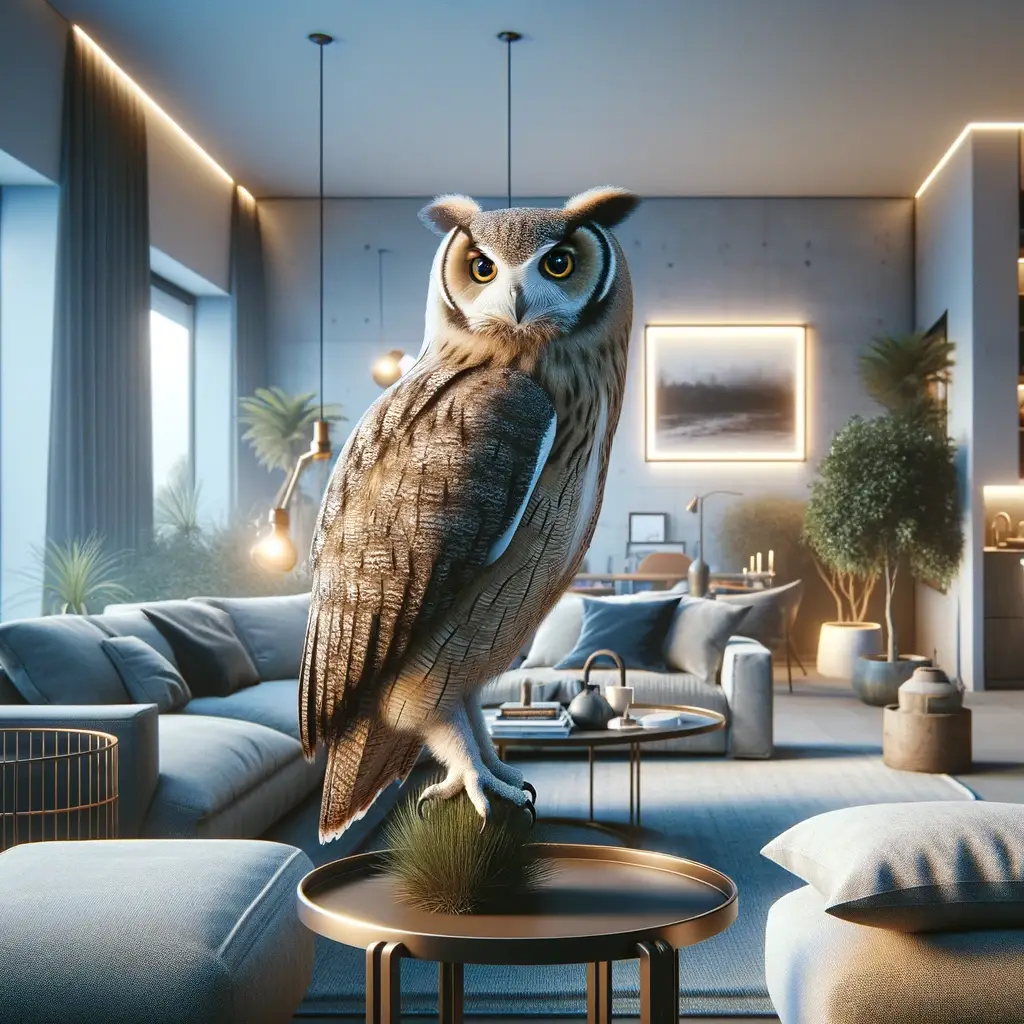
Complexities of Owning Pet Owls: What You Need to Know
The idea of having an owl as a pet sparks excitement and curiosity among many. However, the reality of caring for these fascinating birds is far more complex than it might seem at first glance. With the data collected from various websites on owl pet ownership, we aim to shed light on the unique challenges and realities that come with having an owl as part of your family. It’s essential to recognize that in most countries, including the United States, keeping owls as pets comes with strict regulations and requires special permits. This legislation is in place to ensure the protection and well-being of these majestic birds, emphasizing the need for potential owners to undergo necessary training and prepare proper facilities.
Moreover, the concept of pet ownership takes on a different meaning when it comes to owls. Those who are licensed to keep an owl for rehabilitation, educational, or breeding purposes do not “own” the bird in the traditional sense. Instead, the U.S. Fish and Wildlife Service retains stewardship, highlighting the bird’s welfare above all. When considering an owl as a pet, it’s crucial to understand the top 10 reasons why this may not be the ideal choice for everyone:
- Vacations and business trips become challenging, as owls require trained caregivers and are stressed by routine changes.
- Destructive behavior is common, with owls capable of shredding household items and damaging woodwork.
- Noise during mating season can be disruptive, especially at night.
- Most owls do not enjoy being petted, retaining their natural instincts.
- Owls are high maintenance, requiring daily care, large enclosures, or regular flying for exercise.
- Long lifespan means a long-term commitment, with some species living 30 years or more.
- Sharp beaks and talons pose a risk to caregivers.
- Specialized care needs make finding a knowledgeable vet crucial.
- Feathers, pellets, and poop require non-stop cleaning.
- Strict diet requirements involve daily preparation of whole animals.
With these points in mind, it’s clear that owning an owl is not akin to caring for a traditional pet. Before making the commitment, potential owners must weigh these realities against their capabilities and readiness to meet the unique needs of these birds. Stay informed and make a responsible choice for both you and the owl.
FAQ: Owning Pet Owls
Owning a pet owl is a topic surrounded by intrigue and curiosity. Here, we address some frequently asked questions to provide deeper insight into what it really means to have an owl as a pet.
Is it legal to own an owl as a pet?
Owning an owl requires special permits in most countries. In the United States, private individuals cannot keep native owls as pets without being licensed for rehabilitation, educational, breeding purposes, or certain legal falconry uses.
What are the main challenges of having an owl as a pet?
1. Vacations and business trips pose difficulties as owls need routine and trained care.
2. Owls can be destructive, damaging household items with their natural instincts.
3. The noise during mating season can be disruptive.
4. Daily care and special housing are essential for an owl’s well-being.
5. Owls have a long lifespan, requiring a long-term commitment from their caregivers.
Do owls like to be petted?
Most owls do not enjoy being petted as they retain their natural instincts and behaviors that do not include traditional pet interactions.
What does an owl’s diet consist of?
Owls are strict carnivores and need a diet of whole animals, including rodents and small mammals. Their food often needs to be prepared by removing parts that are not consumed.
Can any veterinarian care for an owl?
Finding a veterinarian with the necessary training to care for owls can be challenging. You’ll need to locate a vet comfortable working with owls and experienced in their specific health needs.
How much cleaning is involved in owning an owl?
Keeping an owl involves non-stop cleaning due to feathers, pellets, and poops. The process includes daily maintenance and deep cleaning to manage the mess and odor effectively.

The Financial Cost of Owning an Owl
Owning an owl involves not just a deep understanding of their needs and legal responsibilities but also a significant financial commitment. Pet owls are one of the more expensive pets to maintain, given their specific diet, housing, and healthcare needs. This section highlights the key expenses to help potential owl owners budget for their feathered friend.
| Expense Category | Estimated Cost |
|---|---|
| Special Permits | $50 – $200 annually |
| Enclosure/Housing | $500 – $2,000 (initial setup) |
| Diet/Food | $50 – $150 monthly |
| Veterinary Care | $100 – $300 per visit |
| Accessories (perches, toys, etc.) | $100 – $300 |
The initial costs of setting up an appropriate enclosure can be steep, and that’s before considering the ongoing expenses of owl food, veterinary care, and necessary permits. Unlike traditional pets, owls require a diet of whole animals, adding to the monthly cost of care. Regular veterinary visits are another crucial aspect of owl ownership, as their health needs can be complex and require specialists.
While the idea of owning an owl might seem intriguing, it’s essential to consider whether you’re prepared for the fiscal responsibilities that come with it. Owning an owl is a serious commitment and requires substantial ongoing investment in their well-being.
Before embarking on the journey of owl ownership, potential owners should thoroughly research and consider if they can meet both the care and financial requirements. Owls are magnificent creatures that deserve the highest level of care from those who choose to take on the responsibility.
Fur Facts: Owls as Pets
Thinking about adding an owl to your household? Here are some fur facts that might surprise you. While many find the prospect of owning an owl alluring, the reality involves more than meets the eye.
- Owls are not your typical cuddly pets. Unlike dogs and cats, most owls prefer not to be petted. Their natural instincts still dominate, making traditional pet interactions uncomfortable for them.
- Ready for a commitment? Consider the long-term responsibility. Owls have a remarkably long lifespan. Some species can live up to 30 years or more in captivity. This means caring for your feathery friend for decades.
- Cleaning will become a regular part of your daily routine. Owls molt thousands of feathers every year, and they also produce pellets and droppings that require daily cleanup. The level of care and attention to cleanliness with an owl is significant compared to more common pets.
- Feeding your owl won’t be as simple as opening a can of food. Owls are carnivores that require whole animals in their diet. This means preparing meals that might include rats, mice, or other small animals, which could be a deal-breaker for some potential owl owners.
While owls might be mesmerizing creatures with their silent flight and striking eyes, it’s clear that they require a unique kind of care and commitment. Before you decide to welcome an owl into your home, make sure to consider these aspects thoroughly.

Fur Facts: The Challenge of Owls’ Natural Instincts
It’s not just about the practical aspects of care and feeding; understanding and navigating an owl’s natural instincts is a significant challenge of having one as a pet.
- Prey drive: Owls’ natural instincts include hunting and killing prey. This can lead to destructive behavior in a home setting as they may attack stuffed animals, pillows, or other items they perceive as prey.
- Nightlife: Remember, owls are nocturnal. They are active and vocal at night, especially during mating season. This can lead to sleepless nights for you and possible complaints from neighbors.
- Human interaction: While some owls may become accustomed to their human caretakers, their natural instinct is not to seek affection or cuddling like a dog or cat might. Understanding and respecting their nature is key to a harmonious relationship.
Owning an owl is not for everyone. It requires a deep understanding of their unique needs and instincts, as well as a commitment to meeting those needs over the long term. If you’re considering an owl as a pet, make sure you’re prepared for all it entails.
Owls are fascinating creatures that require specialized care and understanding. They are not typical pets, and owning one comes with challenges that many may not expect. Careful consideration, preparation, and a willingness to learn about their unique needs can lead to a rewarding experience for the right person. But it’s clear, owls are not suited for everyone’s lifestyle or expectations of pet ownership.
Legal Implications and Practicalities of Owl Ownership
Owls are captivating creatures with their mysterious allure and striking appearance. However, the intricacies of legally and practically caring for them may deter many from pursuing this path. Let’s delve into the specific challenges highlighted by expert sources that emphasize why owning an owl is a considerable responsibility, far removed from ordinary pet care.
- Legal constraints: The legalities surrounding owl ownership are stringent. In the United States and most other countries, keeping owls without special permits is illegal. These permits are typically only issued for rehabilitation, educational, or breeding purposes, underlining the complexity and commitment required in providing appropriate care for these birds.
- Specialized care: Owls demand a level of care that goes beyond what most veterinarians can offer. Finding a vet skilled in handling owls is crucial for their health and well-being. This challenge is compounded by the need for a diet of whole animals, meticulous attention to their living conditions, and regular maintenance of their physical health.
- High maintenance: The commitment to owning an owl extends to daily feeding, cleaning, and interaction. For those with human-imprinted owls, the requirement for frequent and specialized attention is even more critical. Moreover, owls capable of flying need either large enclosures for exercise or to be flown regularly, adding to the complexity of their care.
- Lifespan: Owls can live for many years, with some species reaching over 30 years of age in captivity. This longevity translates into a long-term commitment, ensuring that they receive the care and attention they need throughout their lives.
- Cleanup: Owning an owl involves constant cleaning due to their natural behaviors, including molting, producing pellets, and their unique bathroom habits. The effort required to maintain a clean and healthy environment for an owl is significant and ongoing.
This closer look at the legalities, care requirements, and long-term commitment needed for owl ownership illustrates the considerable challenges involved. While the thought of having an owl as a pet may be appealing, the realities are far more demanding and less glamorous than anticipated. Understanding these facets is essential for anyone considering adding an owl to their family, ensuring they are fully prepared for the responsibilities ahead.
Owning an owl as a pet is not a decision to be taken lightly. It requires a deep understanding of their needs, a willingness to meet those needs over an extended period, and a recognition of the legal implications involved. Owls are extraordinary creatures that deserve the highest level of care and respect. Before embarking on the journey of owl ownership, it’s crucial to consider if you can genuinely provide the environment and lifestyle these magnificent birds require.


Environmental Impact of Keeping Owls as Pets
Owls hold a mystical allure, drawing the interest of many who dream of keeping these majestic creatures as pets. However, beyond the legal and practical challenges lies a significant issue often overlooked: the environmental impact of keeping owls in captivity. Understanding this aspect is crucial for anyone considering owl ownership.
Owls, as apex predators, play a vital role in maintaining the balance of ecosystems by controlling rodent populations. Removing owls from their natural habitat can disrupt local ecosystems in ways that are not immediately obvious. Here are key points to consider:
- Disruption of natural prey-predator dynamics: Owls contribute to controlling the population of their prey, which includes rodents and smaller mammals. Captive owls do not serve this ecological function, potentially leading to overpopulation of these species in the wild.
- Genetic diversity loss: Captive breeding of owls, especially if not managed with conservation goals, may lead to a reduction in genetic diversity among owl populations. This loss can affect the resilience of species against diseases and environmental changes.
- Negative impacts on wild populations: The demand for pet owls can fuel illegal trapping and trade, further threatening wild populations. Illicit activities not only remove owls from their natural environments but also disrupt breeding and hunting patterns.
- Invasive species concerns: In cases where pet owls escape or are released into the wild in non-native ranges, they can become invasive species, competing with local wildlife for resources and possibly endangering native species.
The allure of owning a pet owl cannot be understated, yet it’s imperative to weigh these environmental considerations. Responsible wildlife enthusiasts can support owl conservation efforts through donations, volunteering, or participating in citizen science projects. This way, you can contribute to the well-being of these remarkable birds without the complexities and ethical concerns of direct ownership.
While the fascination with owls is understandable, the decision to keep one as a pet carries broader implications than many might anticipate. Understanding the environmental impact of owl ownership encourages a more informed, respectful approach to interacting with these magnificent creatures and their habitats.
Explore more on responsible wildlife appreciation and conservation on FurFacts.net.
Beginner Guide to Raising Quail at Home
What are the Signs of a Dog Concussion?
What Causes Your Dog’s Ears to Smell Bad?
When your dog’s ears start to emit an unpleasant odor, it might leave you puzzled…
Methimazole Treatment for Cat Hyperthyroidism
Methimazole plays a crucial role in managing feline hyperthyroidism, a condition marked by an overactive…
Got Hummingbirds in your Backyard? Here’s How to Care for Them.
Why Does Your Cat Pee Outside the Litter Box?
Cat’s Litter Box Issues It’s not uncommon for cat owners to face the frustrating dilemma…




